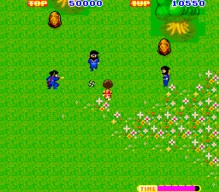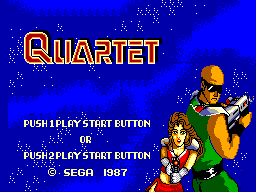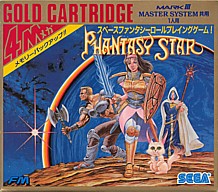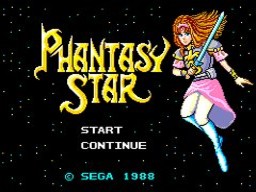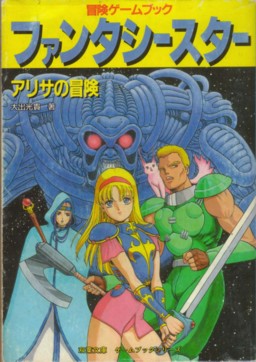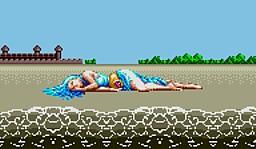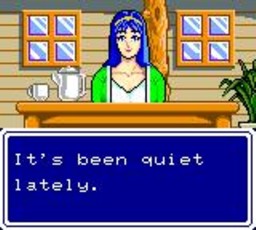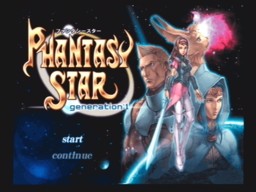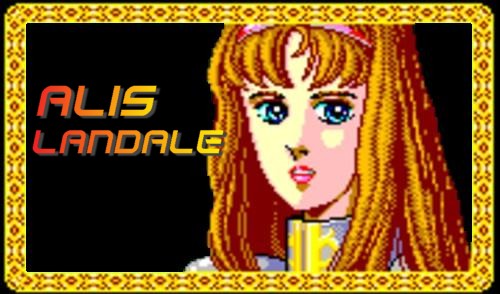 |
|
Character Information :
|
|||||||||||||||||||||
|
Before we get into her impact, let's do a nice overview of her appearance. Alis (also named as Alisa Landeel, by the way), was designed by Rieko Kodama, a female programmer who worked for Sega and had her share of female characters, such as Ninja Princess (later ported and altered for the Master System as The Ninja) and Quartet, which features a female hero. Kodama envisioned Alis as a determined, powerful, yet overtly feminine character. She is a mere fifteen years in age and witnesses her brother killed at the hands of La Shiec, then deciding to find revenge. Though her quest is a violent one and perhaps counter to typical stereotypes, Alis is clothed in a pink skirt with light armor, a pink headband, bracelets, panty hose and boots. At first glance, she is clearly female, but at the same time plays a dominant role in Phantasy Star, and it is this image below that would become her most recognizable presentation, though she would reappear in different forms throughout the coming years. More recently, she has returned to her original look, with some updates. Unfortunately for Master System fans, she only appeared in a single game, which seems strange considering the impact the Phantasy Star series had on the role-playing genre as a whole. This being said, the fact cannot be avoided that Alis' importance is also tied up in the first game of the series, which we'll overview briefly before moving further. This, in fact, may be the main reason for her current position in obscurity.
Phantasy Star was headed and masterminded by Ossale Kohta, who we've all become acquanited with for his design of Alex Kidd, the most recognizable SMS character in the console's history. In the early 1980s, Sega had yet to produce an RPG title of any significant impact, though The Black Onyx had been in production four years prior by our friend mentioned above. Seeing the popularity in Japan of the Dragon Quest series for the Famicom, Sega decided to move forward with a title of grand proportions. Phantasy Star was to be the biggest, most detailed, most coloful and quite simply the greatest title ever released up until that time. They attempted to push the envelope on a number of areas including the addition of monster animation frames during battle, but the most significant addition in terms of our article here is that they chose to use a female protagonist playing the dominant role. This may not seem important, but up until this time women didn't exactly have the best position in the history of video games.
Up until the coming of Phantasy Star, women rarely made an appearance in video games. The first true appearance of a female character was Ms. Pac-Man in 1981, which was intended as something of a marketing tool in order to entice girls to play more arcade titles. Thus, though an immensely popular game, it relies simply on the same format made popular by Pac-Man and is little more than a hack that places the female character in a subservient role, though she may be the main element in the game. Following this, female characters tended to frequently appear as the "woman in distress," such as Pauline in Donkey Kong in the same year as Ms. Pac-Man, who was actually referred to simply as "lady" before she was even given a name. At the same time, women were, as usual, being utilized as sex objects, appearing in a few pornographic games for the Atari 2600 in the early 80s. One of these, the notorious title Gigolo released in 1982 on a combo-cartridge with Bachelor Party, has you walking around a small town working as a prostitute. Basically you go to a house and move the joystick to cause your character to ride men in order to make money. That's exactly what's going on above, I swear that's a real screenshot. Kind of interesting that a game where you play a woman selling her body is called Gigolo, the assumption being the programmers figured it would seem less offensive than calling it Hooker or Whore in spite of what you're actually doing in the game. Athena then appeared in the arcades around 1985 and one year later on the NES in a horrible port, but yet, even though the player took control of a female character, she was techincally a goddess and thus inhuman, which kind of takes away from the idea of having a female character as the main protagonist. In the same year, Taito had even released an arcade title utilizing the same technology as Dragon's Lair called Time Gal, but though Reika, the main character, was female the game only appeared in Japan and later on a handful of systems such as the Sega CD. Not many video game fans, even the most hardcore of freaks, have even heard of this game because it was largely unknown, and due to this the idea of the female character had yet to catch any attention. That is, however, until the appearance of Alis Landale.
Sega took something of a gamble when they decided to release a role-playing game with so many variations on a genre still in its infancy. Three-dimensional dungeons, a departure from the traditional fantasy world format, monster animations during battle, an intricate plot that didn't simply involve "girl taken, kill big monster thing, get girl, win," and of course, the most important aspect for our purposes, a female character heading up the leading role. As mentioned earlier, this wasn't necessarily something new, but it was in the sense that the character was actually developed and did not play a role traditionally assumed by women. Not only was she the main character, Alis also wielded a sword and could take a huge amount of damage when her defense stats were raised high enough, completely breaking with tradition and creating a new symbol of the female video game character. In addition, she was fronting the greatest venture of quite possibly the entire life of the Sega Master System. Though not sold in excessive numbers like a game such as Super Mario Bros., Phantasy Star was one of the major factors for the SMS holding ground in the United States and may have been the reason it picked up so well in Europe and Brazil. So important was this title that it still resonates in the RPG genre until today. The series itself is still ongoing, but the effect it has had on various programmers, designers and the history of video games is quite obvious but beyond our purposes here.
It's impossible to theorize exactly what happened to her over the years or why her image wasn't pushed any further, but a few factors definitely come into play. We've already mentioned the first one, but let's go over it again. Alis was part of a vast game, one that involved not only her presence, but many other characters. Thus, though the main character of the title, it was not her alone that drove the action. Second, Sega didn't follow up with any sequels to this incredible game for the Master System. Why they didn't but yet released a few Alex Kidd sequels that were total bombs may never be known, but obviously, making a character and then never using her again for the system she first appeared on didn't have a good effect on the development of her image. Third, and most imortant, even when Sega did finally make Phantasy Star II, it did not feature Alis. Of course, they weren't required to do this, but removing her as a major character certainly hindered her presence. She is mentioned in the game as something of a legend, but since the title takes places centuries after her death, it hardly does justice to her position in video game history. This time, they chose a descendant named Rolf and further developed the world of Phantasy Star and not the characters. Of course, they weren't required to do anything, but again this was definitely a major impact on Alis' career as one of the most, if not the most important female video game character of all time.
As Sega went even further with the Phantasy Star series, Alis never made an appearance. Phantasy Star III came and went to the disappointment of fans (this is often viewed as the weakest game in the series), but no Alis so let's not even comment on that. Fans were then given a bit of a treat two years later, well in Japan anyway, with the release of Phantasy Star Gaiden. Here, you get to play as Alis' daughter, Mina and learn that after the first game, Alis leaves Palma to start her own colony. She makes an appearance in the game and is a playable character later on, but unfortunatley does not play the role as the main character, since her daughter was utilized in order to target younger audiences, much like Final Fantasy Adventure Quest for the Super Nintendo Entertainment System. You eventually meet up with her and drive in her, you heard me right here, pink car, which then turns into a boat so you can access the final area of the game. It is here that she's finally playable, but as you can see has no major impact on the overall plot, but you can see how the programmers have almost shied away from her previous image, turning her into more of a, shudder, "Barbie" figure. See the later image of her below in the line-up to see how she changed.
After this, the Phantasy Star series continued and more female characters made their appearance, none of which seemed to have the same impact as Alis Landale. She was updated significantly for the Playstation 2 title Phantasy Star Generation 1, but the game was simply an update of the original title and not a continuation of the series in any way. It has yet to be seen whether she will ever be utilized again in as significant a format as she was on the Sega Master System, but the future looks dim for Alis Landale. Her position has been trumped by characters such as Lara Croft in the Tomb Raider series and it's doubtful she will ever appear in video games again. Alis left her mark on the video game industry, but whether this has had any lasting impact on the history of women in video games has yet to be seen. With series like Tomb Raider on the market it seems hopeful, but yet also has to compete with titles that reinforce age-old stereotypes such as Dead Or Alive Xtreme Beach Volley, which had the sole selling point of showing voluptous young girls in bathing suits jumping about. Then, you still have some characters like Samus Aran, but the problem there is though she may be female, this is generally completely obscured by the extremely huge suit of armor she wears, which gives no indication of feminine form. Her female nature is hidden behind a mask and has been present since her first appearce in 1986 where the ultimate suprise was the ending, when Samus removes her suit and you discover she's female and then get to play through the game again with her wearing a skimpy bikini. I sense a pattern... | |||||||||||||||||||||
|
Character
- Gameography :
|
|
| Master System Titles: Game Gear Appearances:
|
|
Images of Alis Landale :
|
|||||||||
|
|||||||||
|
Related Links :
|
|
| |






